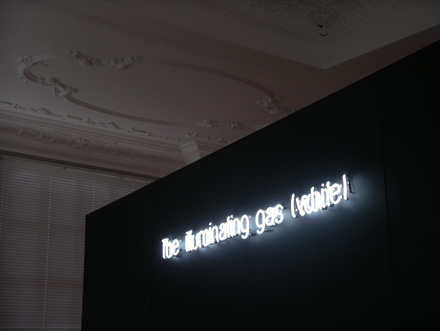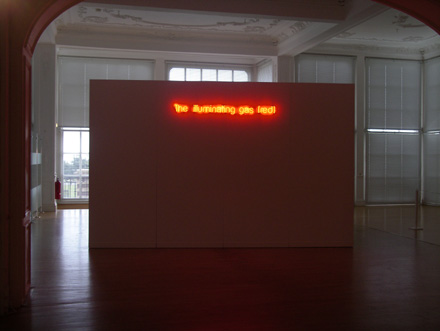The Illuminating Gas
2006
Neon Lights
During his visit to Herne Bay, Duchamp became fascinated by the then recently-opened Herne Bay Pavilion and Pier, the second-longest in the country at the time and one of the first to have outdoor electrical lighting; a clipped photograph of the Pavilion at night and a written note were later found in a box of the artist’s material relating to The Large Glass. These neon works consist simply of the phrase ‘the illuminating gas’ — taken from Duchamp’s notes — followed, in parentheses, by the colour of the neons themselves, red, white and yellow. It has been suggested — and disputed — that the phrase refers to Duchamp’s supposed interest in matters alchemical, a supposition that has influenced other works here. These works are both straightforwardly literal — a description of their own states, perhaps reminiscent of Joseph Kosuth’s self-descriptive work from 1965 Five Words in Blue Neon — and emblematic, the red, white and yellow colours denoting various stages of material transmutation within the alchemical process, from white (which emerges from black), towards the final stages of red and yellow. According to the young French alchemist Albert Poisson, ‘These colours must appear one after the other in an unvarying order; their regular succession indicates that the Great Work is going well.’
The illuminating gas (yellow) was installed in the gallery in which the film Zugzwang (almost complete) was shown, and was timed to illuminate the room between screenings.
2006
Neon Lights
During his visit to Herne Bay, Duchamp became fascinated by the then recently-opened Herne Bay Pavilion and Pier, the second-longest in the country at the time and one of the first to have outdoor electrical lighting; a clipped photograph of the Pavilion at night and a written note were later found in a box of the artist’s material relating to The Large Glass. These neon works consist simply of the phrase ‘the illuminating gas’ — taken from Duchamp’s notes — followed, in parentheses, by the colour of the neons themselves, red, white and yellow. It has been suggested — and disputed — that the phrase refers to Duchamp’s supposed interest in matters alchemical, a supposition that has influenced other works here. These works are both straightforwardly literal — a description of their own states, perhaps reminiscent of Joseph Kosuth’s self-descriptive work from 1965 Five Words in Blue Neon — and emblematic, the red, white and yellow colours denoting various stages of material transmutation within the alchemical process, from white (which emerges from black), towards the final stages of red and yellow. According to the young French alchemist Albert Poisson, ‘These colours must appear one after the other in an unvarying order; their regular succession indicates that the Great Work is going well.’
The illuminating gas (yellow) was installed in the gallery in which the film Zugzwang (almost complete) was shown, and was timed to illuminate the room between screenings.

